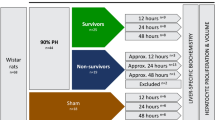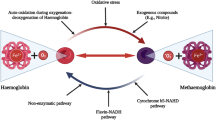Abstract
LOCALIZATION of injury to specific zones in the liver lobule after the administration of many toxins is well recognized1. Carbon tetrachloride, an agent extensively examined in hepatotoxicology, characteristically produces centrilobular necrosis and lipid accumulation. Himsworth2 and, more recently, Brody3 suggested that the centriobular location of injury after acute carbon tetrachloride intoxication resulted from centrilobular ischaemia secondary to the hydrocarbon's effect (directly or indirectly) on blood passing from the periphery to the centre of the lobule. This concept has been challenged on several grounds including the observation that the earliest signs of parenchymal cell injury precede vascular changes associated with ischaemia4. Several investigations have indicated that hepatic cells within different zones of the lobule have dissimilar function5. This has been ascribed to the relation of the hepatic cell to the blood flow through the lobule which causes these cells to adopt particular functions in accordance with available substrates or metabolites in the blood. Wilson describes certain zonal functions as representing habitual patterns of activity which become characteristic of hepatocytes in a particular location6. Zonal heterogeneity of function may explain the centrilobular location of acute carbon tetrachloride injury if it is assumed that hepatocytes in this location are susceptible to its effect.
This is a preview of subscription content, access via your institution
Access options
Subscribe to this journal
Receive 51 print issues and online access
$199.00 per year
only $3.90 per issue
Buy this article
- Purchase on Springer Link
- Instant access to full article PDF
Prices may be subject to local taxes which are calculated during checkout
Similar content being viewed by others
References
Stoner, H. B., and Magee, P. N., Brit. Med. Bull., 13, 102 (1957).
Himsworth, H. P., The Liver and Its Diseases (Harvard University Press, Cambridge, Mass., 1954).
Brody, T. M., Calvert, D. N., and Schneider, A. F., J. Pharmacol. Exp. Therap., 131, 341 (1961).
Brauer, R. W., Physiol. Rev., 43, 115 (1963).
Novikoff, A. B., and Essner, E., Amer. J. Med., 29, 102 (1960).
Wilson, J. W., in Liver Function (edit. by Brauer, R. W.), 182 (Amer. Inst. of Biol. Sciences, Washington, D.C., 1958).
Sigel, B., Baldia, L. B., and Dunn, M. R., Surgical Forum, 16, 288 (1965).
Sigel, B., Baldia, L. B., Dunn, M. R., and Dimbiloglu, M. E., Fed. Proc. (abstract), 25, 479 (1966).
Brauer, R. W. NATO Symposium, The Biliary System, 101 (Blackwell Scientific Publications, 1965).
Author information
Authors and Affiliations
Rights and permissions
About this article
Cite this article
SIGEL, B., BALDIA, L., DUNN, M. et al. Carbon Tetrachloride Effect on Liver Autotransplants with Totally Reversed Blood Flow. Nature 213, 1258–1259 (1967). https://doi.org/10.1038/2131258a0
Issue Date:
DOI: https://doi.org/10.1038/2131258a0
This article is cited by
-
Heterogeneity of cytochrome P-450 distribution in the hepatic lobule revealed by carbon tetrachloride
Bulletin of Experimental Biology and Medicine (1979)
-
Autoradiographische Untersuchung über die Proteinsynthesestörung in der Mäuseleber nach CC14 -Intoxikation
Virchows Archiv B Cell Pathology (1970)
Comments
By submitting a comment you agree to abide by our Terms and Community Guidelines. If you find something abusive or that does not comply with our terms or guidelines please flag it as inappropriate.



